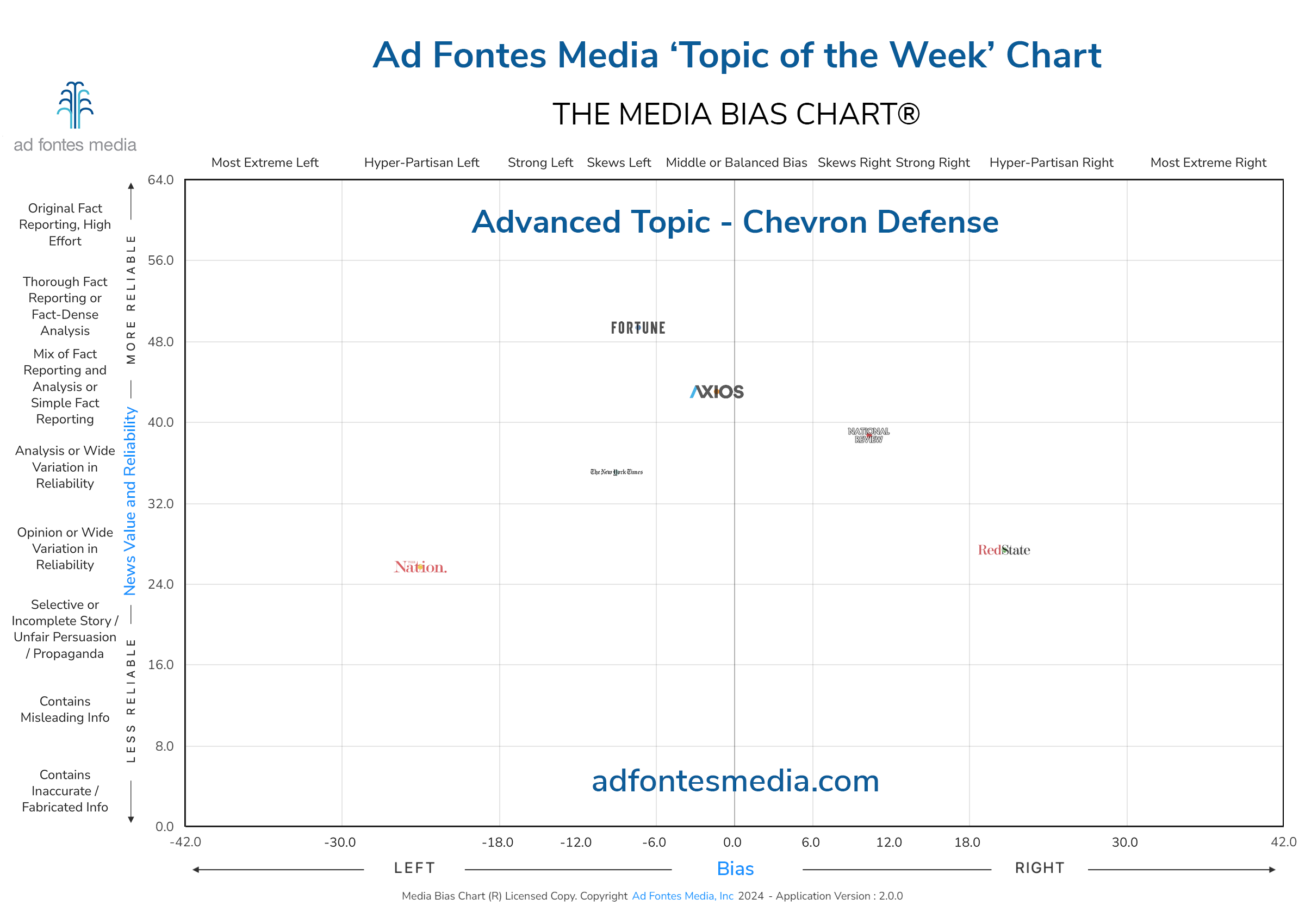Menu

As SCOTUS deliberates an important case about federal regulation, the media argues opposing sides of the debate
The Media Bias Chart examines the responses to SCOTUS deliberating on the Chevron defense
Author:
Sara Webb
Date:
01/26/2024
The U.S. Supreme Court is getting set to hear a case that could bring fresh constraints on federal agencies’ ability to craft legislation including energy and climate regulations. Our analyst team took a deep dive into the media coverage of this important decision in this week’s Topic of the Week.
Each week, Ad Fontes Media chooses a widely covered trending news topic to share insight into how our analysts rank news coverage for the Media Bias Chart®. To do this, we select six articles reporting on the same story from different outlets to show how each treated the subject.
Once we choose a set of articles, pods of analysts with diverse political perspectives (one right leaning, one center, and one left leaning) read each article and use Ad Fontes Media’s content analysis methodology to determine its bias and reliability. These ratings inform the articles’ placement on that week’s special Media Bias Chart.
This week, the story is a little legally complicated, but it revolves around something known as the Chevron doctrine. Paraphrasing from a legal blog, this is a rule that calls for judges to accept reasonable interpretations of a statute by an administrative agency, even if those judges might have favored different interpretations.
It was generally agreed that a federal agency’s statutory arguments were entitled to respectful consideration, given an agency’s expertise about the statute it administers and the practical and technical issues involved in implementing the law. This had left many gray areas, and while the case going before the Supreme Court is ostensibly about a fisheries rule, the decision could broadly affect many areas of regulation.
The current two cases before the court deal with this doctrine in regard to fishing. To prevent overfishing, in New England a federal monitor is required to ride along on half of the fishing trips. While this position was paid by the federal government, that changed in 2020, and the fishing boats were then required to pay for these monitors, threatening the livelihoods of some of these sometimes quite small fishing companies. The companies are seeking to rid themselves of the federally mandated but not paid for tagalong federal monitors.
Our analyst team took a closer look at several articles from various media outlets on this topic: “Supreme Court case could limit executive power on climate, energy” from Axios, “Years after Trump’s White House vowed to destroy the administrative state, 2 of his Supreme Court appointees look poised to strike a big blow” from Fortune, “Will the Supreme Court Show a Little Humility?” from The New York Times, “When ‘Law Runs Out,’ the Government Runs Out” from National Review, “Today’s Supreme Court Argument Hints That It Will Drive a Stake Through the Heart of Federal Rulemaking” from Red State, and “We Are Witnessing the Biggest Judicial Power Grab Since 1803” from The Nation.
The bias and reliability scores for each of these articles can be found on our Topic of the Week page. We will be looking closer at the articles from Red State and The Nation.
The Nation is the oldest weekly magazine in the United States, based in New York. Founded in 1865 by abolitionists, the magazine publishes commentary on politics and culture, with past contributors including Hunter S. Thompson and Martin Luther King Jr. From all of the articles that we have rated from this site, The Nation’s aggregate score for reliability is 32.25, placing it in the “analysis or wide variation in reliability” category, and for bias is -18.75, placing it into the “hyper-partisan left” category. This week’s article scored 25.67 for reliability (“opinion or wide variation in reliability”) and -24 for bias, placing it in the same general category in which it normally falls.
This article begins by explaining the Chevron defense as “the idea that courts should defer to executive agencies when applying regulations passed by Congress” and calls it one of the most important cases of the year (although it counterpoints with, “The court is also set to decide whether a raving, orange criminal can run again for president”).
The article lays out the argument against getting rid of the doctrine, stating that if “conservatives get their way, elections won’t really matter, because courts will be able to limit the scope of congressional regulation and the ability of presidents to enforce those regulations effectively. And the dumbest justice of all, alleged attempted rapist Brett Kavanaugh, basically said so during oral arguments.”
It also brings up an interesting point in examining the history behind the Chevron decision, explaining that “the head of the EPA in 1984, the one who was trying to make it easier for polluters, was Anne M. Gorsuch, Justice Neil Gorsuch’s mom. Of course, as a Reagan appointee, Anne’s goal was to destroy the EPA from the inside… ” and Neil is just “carrying on the family business.” Ultimately, the author asserts that “without Chevron deference, every single agency rule is likely to be challenged in court by some disaffected party.”
RedState is a conservative blog and website launched in 2004 by three bloggers, Joshua Treviño, Ben Domenech and Mike Krempasky. It is owned by the Salem Media Group. From the articles that we’ve rated from this site, its aggregate reliability score is 21.83, placing it in the “selective or incomplete story/unfair persuasion/propaganda” category, and its bias score is 22.26, or “hyper-partisan right.” The scores from this week’s article placed it at 27.33 for reliability and 20.67 for bias, both in the same range as the average.
The article spends a few paragraphs explaining the Chevron doctrine but then calls the fishing cases in front of the Supreme Court “prime examples of the danger Chevron poses to a free society.” Red State reported that after two of the fishing companies sued, “The district court and appeals court said, ‘Well, the law is ambiguous, and making those swine pay for their monitors is one way of doing it; sounds good to me, and what time is the limo picking us up for lunch?’”
The article then consists of block quotes from Slate magazine, a liberal publication, which this author uses to counterpoint the silliness of the opposition’s fears: “Without Chevron deference, it’ll be open season on each and every regulation, with under informed courts playing pretend scientist, economist, and policymaker all at once.” The article closes with, “A decision is expected in June, and I’ll be off work for a month, getting drunk on liberal tears.” Not subtle at all.
Both of these articles hit below the proverbial belt. They use ad hominem attacks to target specific people, steep in the joy of liberal tears or bemoan the fall of society as we know it, and they contain more opinion than fact or analysis.
As you finish reading these articles, ask yourself, how do you feel? Are you mad? Worried? Because more than anything, that is what these articles have in common: evoking a strong emotional response to keep readers thinking and feeling a certain way. Is that the way of bipartisan cooperation and understanding? No, no it is not.
These are just two examples of the thousands of articles our analysts have rated for reliability and bias. If you want a look at the larger media landscape or are curious to see how our analysts have rated your favorite sources, head on over to our website and check out the resources we have available. And don’t forget to come back for another examination of our Topic of the Week.
Want to stay informed on all of the work by our team? Join our free mailing list!


